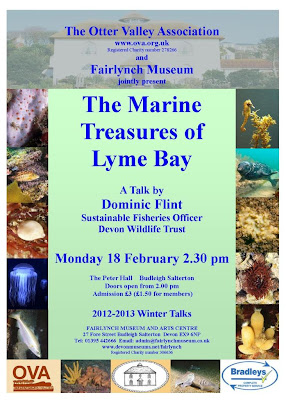The Marine Treasures of Lyme Bay
Could this really be the Year of the Sponge?
My crazy fantasy at http://budleighbrewsterunited.blogspot.co.uk/2011/11/absorbing-read.html about a Budleigh Sponge Day may not have been so crazy after all.
I've just read Simon Barnes' piece entitled Unexplored wilderness at the end of the pier in The Times at http://www.thetimes.co.uk/tto/opinion/columnists/simonbarnes/article3669027.ece reflecting on the wonderful hidden world of the Cromer Shoal Chalk Reef off the coast of
That "new to science" phrase struck a chord, still reeling as I am from having written 70,000 words about Victorian spongiologist Henry Carter FRS (1813-95) as part of my own exploration of 19th century science, a world previously foreign to me.
"New to science" was the excited and triumphant clarion-call favoured by Victorian botanists, zoologists, geologists and all our other worthy ancestors who believed they were making the world a better place with the extraordinary finds that they were making all over the planet.
Examining a 'haul' on board the Challenger
Image from F. Whymper The Sea: Its stirring Story of Adventure, Peril & Heroism London 1880
Finds
which ranged from the dredged-up hauls on HMS Challenger, yielding over 4,000 marine species "new to
science" between 1873 and 1876 to the rare and exotic plants that they
found in the jungles of South America. Very often the finds made by these brave
or obsessed explorers were followed by death from disease or shipwreck.
Above: The sponge Clathrina Coriacea (Montagu, 1818). Henry Carter
wrote of its “chaste and exquisite network”
Image credit: Fiona Crouch
Image credit: Fiona Crouch
Henry
Carter, the town's most celebrated scientist born in Budleigh
Salterton, found 17 different species of sponge growing on the coast here following
his retirement in 1862 and was often moved by their beauty.

http://colinmunrophotography.com/blog/
Our town looks out on to Britain ’s largest inshore marine protected area
(MPA) and it's only right that an event arranged jointly by the Otter Valley
Association and Fairlynch
Museum Lyme
Bay
Devon Wildlife Trust has been
working to protect the reefs in Lyme Bay since the 1990s with the result that this part of
the county's coast is probably the best understood area of seabed in the UK
Dense beds of mature pink seafans (Eunicella verrucosa), some almost a metre across, growing on pristine reef in
Image credit: Colin Munro
Speaker Dominic Flint has been Sustainable Fisheries Officer
at Exeter-based Devon Wildlife Trust for almost two years. Before that he was
Seagrass Officer for Torbay
Coast Bristol University
before going on to further studies at Warwick
and Nottingham Universities ,
gaining a Diploma in Marine Biology and an MSc in Applied Marine Science at the
University of Plymouth Devon and the South West.
Last year saw the fiftieth birthday of Devon Wildlife Trust. In 1962 Lady’s Wood, near South Brent, became DWT’s first nature reserve, but many others have followed since. Today DWT manages 45
nature reserves for wildlife and people, protecting rare species that are at risk of vanishing. The Trust
advises landowners on better managing their land for the benefit of wildlife. It stands up for Devon's environment by lobbying decision makers and campaigning to give a powerful voice to wildlife under threat, working throughout the county to conserve wildlife in urban areas and the countryside, on the coast and in the sea.
Click on http://www.devonwildlifetrust.org/ to read more. It sounds like a really worthy cause. Donations will be most welcome.Monday 18 February 2013 2.30 pm Peter Hall, Budleigh Salterton. Admission £3.00. Otter Valley Association members and Friends of Fairlynch benefit from a reduced £1.50 admission charge to the talks. Please note the change of speaker for this event.
Last year saw the fiftieth birthday of Devon Wildlife Trust. In 1962 Lady’s Wood, near South Brent, became DWT’s first nature reserve, but many others have followed since. Today DWT manages 45
nature reserves for wildlife and people, protecting rare species that are at risk of vanishing. The Trust
advises landowners on better managing their land for the benefit of wildlife. It stands up for Devon's environment by lobbying decision makers and campaigning to give a powerful voice to wildlife under threat, working throughout the county to conserve wildlife in urban areas and the countryside, on the coast and in the sea.
Click on http://www.devonwildlifetrust.org/ to read more. It sounds like a really worthy cause. Donations will be most welcome.Monday 18 February 2013 2.30 pm Peter Hall, Budleigh Salterton. Admission £3.00. Otter Valley Association members and Friends of Fairlynch benefit from a reduced £1.50 admission charge to the talks. Please note the change of speaker for this event.







Comments
Post a Comment